► GR86 and GR Yaris vs 128ti, MX-5 and Seven
► Great value, fun cars under the microscope
► Can anyone do it better than Toyota?
This content was part of CAR magazine’s 60th anniversary celebrations, split over three editions. Want to read more from those editions, as well as get access to more amazing content from CAR? Become a member here with a 99p trial!
With a noise like a dull circular-saw blade rasping its way through slim-gauge aluminium, the GR Yaris’s controlled explosion of an engine goes about ripping its way through another gear, lobbing out a faintly comical slug of drive as it does so. Brittle autumn leaves scatter in the wake of the appropriately copper Caterham ahead, both turbocharged engines greedily ramming fuel/air mix into tiny chambers like toddlers packing cake into their faces.
The road gently writhes this way and that, like a bored fighter jet weaving over empty ocean. Viewed from the Toyota, the improbably tiny Seven 170R is a spectacle. The front end appears to barely roll, while the body of the car, with editor-at-large Ben Barry vacuum-packed within, sways lazily from one side to the other as the physics play out, like a span bridge made liquorice in a hurricane.
And the GR Yaris? With leachy grip and emphatic body control it’s happily holding station, stability control off and the fun dial (the four-wheel-drive system’s front/rear torque split) in its most playful setting, Sport. Over a crest and for a heartbeat we swap the world ahead for nothing but dazzling blue autumn sky. Then it’s down the other side and into a tighter bunch of turns, the Caterham electing not to brake but instead to smear sideways and glide through them. The Toyota, light on its feet and giddying in the confidence it inspires, comes alive as torque courses through its drivetrain, opening up a sandbox of dynamic possibilities. Every corner exit is a joyful blur of interwoven steering and throttle pedal movements as intuitive and as instinctive as the Caterham’s.
Are we having fun yet? Absolutely. But don’t let the Caterham’s ‘I could build that’ simplicity dupe you into thinking that building and selling fun, affordable cars is anything but fiendishly difficult. Expensive to develop, mostly incompatible with platform sharing or economies of scale, (mostly) reluctant to be born of collaboration and tough to justify as manufacturers battle to meet CO2 targets, affordable fun has become a luxury few feel able to indulge.
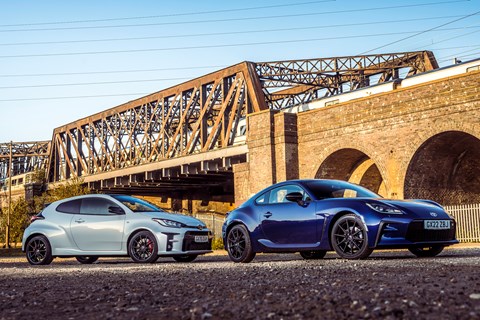
Toyota is different. All those hybrids make for an enviable fleet CO2 figure, and who needs economies of scale when you’re loaded? Together with sub-brand Lexus, Toyota sold more than 9.6 million vehicles in 2021. Yes, 9.6 million. Up 10.6 per cent on the previous year, that performance consolidated its position as the world’s best-selling car maker. And in the fiscal year to March 2022, Toyota racked up all-time records for revenue, operating profit and net income, even if supply-chain issues have grown more challenging since.
So, Toyota can build fun, affordable cars. And crucially, with Akio Toyoda in charge, Toyota wants to build fun, affordable cars. The great Gazoo Racing push may have kicked off in polarising fashion with the Supra, but GR now routinely wins the world’s toughest motor race and we know the GR Yaris is sensational. If the new GR86, a wholesale reboot of the GT86, is touched with the same magic, that surely makes Toyota, for many the arch exponent of the car as an appliance, an unlikely champion of affordable fun?
The 231bhp GR86 costs a remarkable £29,995 on the road; the complex, all-wheel-drive GR Yaris (257bhp from its epic 1618cc turbo triple) £35,610 with the Circuit pack. Ranged against them we’ve the 84bhp Caterham Seven 170R (£35k in this spec, though over £4500 of that’s cosmetic), BMW’s 265bhp 128ti hot hatch (£33k list; £36,595 as tested) and Mazda’s MX-5, here in 2.0-litre, RF guise (£32k, 181bhp).
As we pull up, Ben has plenty of time in which to gather his thoughts – climbing from the Caterham’s second-skin bucket seats and four-point harnesses isn’t the work of a moment. ‘It reminds me of a story Mark Skaife, the Aussie touring car legend, once told me. Nissan forced him to drive a Formula Ford while developing the Skyline, to deliberately make the GT-R feel like a bus and force Skaife to do what he could to move it towards the lightweight single-seater. The Caterham does that here. It’s so small, light and alive, and the steering is sensational. Great balance of grip and power, too.’
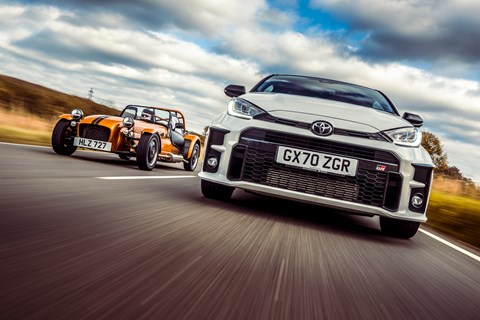
He’s right: the 170R is the best Caterham I’ve driven. The 160 on which it’s based was a thing of joy held back by crude rear suspension, a vague gearshift and a scrappy open differential. The 170R takes the essential rightness of a tiny, ultra-light car with unassisted steering and a grunty turbocharged 660cc triple, and fixes the flaws.
It may only have 84bhp and 86lb ft but, blatting to 60mph from rest in 6.9sec and on to a 105mph-ish top end, the Caterham never feels less than urgent, every twitch of the throttle soundtracked with most ludicrous turbo flutters and exhalations. As ever, though, the real magic is in its malleability. That and the immediate and intuitive relationship between input and response.
You can keep things neat and smooth and almost trance-like. Or you can get a little loose, nudging the rear ever so slightly wide on turn-in, such that you’re almost changing direction without steering. Or you can get lairy, sending the 170R harmlessly sideways and staying on top of it via the telepathic steering, the diff and the turbo grunt (at least until you blunder into the rev limiter).
Ironically given it’s barely changed in half a century, the Seven feels so sublimely evolved for success in its environment you can only suppose David Attenborough must have one, on display next to his copy of Darwin’s On the Origin of Species.
Too much to ask that the GR86 combine the 170R’s intimacy with a shred of practicality? Apparently not. Usable the GR86 undoubtedly is. There’s infotainment, very comfortable and heated seats and a modest boot. And shortly after the first roundabout, navigated with the rear axle floating subtly wide of the path described by the front, it becomes clear there really is a little Caterham magic in the Toyota.
Climb in, note that the flat-four engine means the base of the windscreen is about five inches lower than you expect, and select Track mode for its more lenient interventions. Move away and balance your disappointment at the synthetic steering with the sweet action of the six-speed gearbox, the languid, controlled ride, a semblance of torque (no turbos here, remember, just a 2387cc flat-four) and the burgeoning sense of a beautifully calibrated chassis.
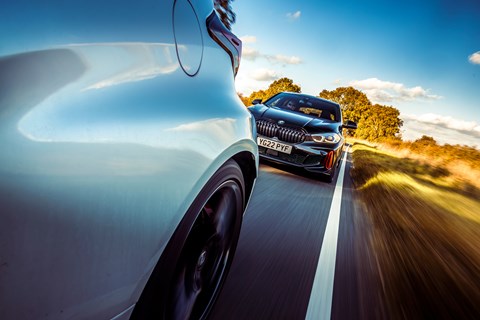
Find a road worth driving, with or without a 128ti looming in your mirrors, and the GR86’s flow is little short of spellbinding. The front axle bites with conviction (something the GT86’s never really did), there’s actual mechanical grip thanks to the Michelin 4S tyres (something the GT86 never really had) and an urgent, free-revving engine with which to overtake, build speed or play (which, again, the GT86 conspicuously lacked). The fluidity with which you can guide the GR86, manipulating its attitude and line with wheel, brakes and throttle is a joy, and surely the reason we’re all here.
And that BMW? The 128ti is outrageously rapid point to point (as fast as the Yaris, in the dry at least), blessed with an interior of a quality many, many leagues above everything else here and, unlike the hugely compromised Caterham or the firmly two-seat Mazda, it’s a genuine family-car proposition. But when it comes to fun, the disappointment hits hard.
The problem, in essence, is a lack of joy. There are some actual issues, like the steering, which is debilitatingly vague, perhaps to hide the power corruption (front-wheel drive, remember), the unyielding ride quality, which delivers masses of body control but does so without a shred of finesse, and (not unusually in 2022, to be fair) the lack of a manual option in a car aimed squarely at enthusiasts.
But the 128ti’s real downfall is its refusal to do anything interesting. The combination of turbo grunt, slick paddleshift transmission and mighty grip (the BMW wears broad 224/40 R18 Pilot Sport 4 Michelins) makes for effortless pace. But that’s hardly the point, as everyone knows – even if they don’t have a 170R on hand for reference.
Ben: ‘The ti badging sets your hopes high, as does the notion of this being a Megane RS by BMW. But there’s no nuance to it, just disinterested clinging-on, with an inexplicable lack of adjustability. Munich could have dialled it in safe in the knowledge the stability control’s there.’
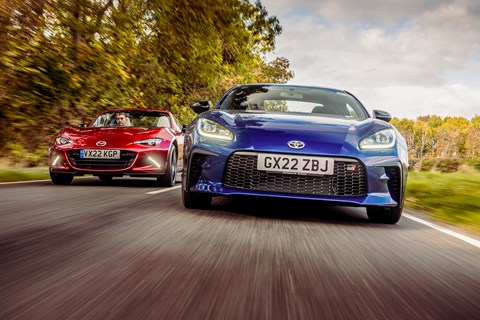
In need of cheering up, I hop into the RF, keen to get on my Colin Chapman high horse about how the powered folding hardtop, with all that extra weight carried high, is blasphemous, but finding it hard not to be immediately swept up in all the stuff the Mazda does so well. It also becomes abundantly clear, quite quickly, that this is car engineered by people who quite like driving. It’s there in the steering, which is tighter and sweeter than the GR86’s, and in the gearchange, which again shades even the Toyota’s, if not the Caterham’s.
On the road the Mazda exudes a gorgeous weightlessness, with a lightness of touch and a pervasive and consistent driver focus that swells your heart with happiness – and serves to highlight just how stern the BMW is by comparison. Not particularly comfortable living on the ragged edge, this MX-5’s body control might be a big step forward over the wayward early 1.5’s but it still rolls markedly in this company. The upside is a fabulous suppleness, and with the hardtop stowed and a few revs on the tacho (the revvy four-cylinder stands in stark contrast to the turbocharged Caterham/Suzuki triple, with its lack of in-gear headroom) the Mazda is addictively good, combining a decent chunk of the GR86’s essential rightness with the always delightful bonus of a roof that disappears.
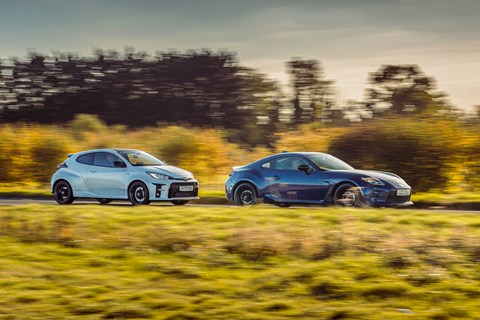
The last drive of the day sees Ben and me heading for home in the Toyotas. With its fabulous driving position and gratifying sense of a machine in sweet equilibrium, not to mention its newfound pace (let the digital tacho unfurl to the right and there’s a real top-end rush), the GR86 burrows its way deeper into my affections. It’s usable, too; far quieter than the GR Yaris, and more supple than either of the hatches here.
The best car here, though? Nope. That’s the other Toyota. A text from Ben pings in as I kill the 86’s engine: ‘Yaris is a MONSTER.’ A final squirt in the mutant city car the following day decides it. That these two cars, so alike on paper and in price, can co-exist within the same portfolio speaks volumes for both GR’s dedication to the cause and how differently the two cars go about scratching the same itch.
Tall and boxy, the GR Yaris shouldn’t work. But when it’s doing its thing you’ll forgive it almost anything, even the lifeguard-spec high chairs and thundering road noise. The little motor kicks out massive thump, the steering is tauter and better connected than the GR86’s, and the combination of agility, predictability and throttle adjustability is little short of mesmerising, thanks in no small part to the rally-bred and dexterous four-wheel-drive system. It is laudably brave in its torque splits and so fast-acting as to feel almost savant.

The Toyotas stand apart as pretty special examples of a breed of car not long for this world. So special, bizarrely, that you’d happily own both.